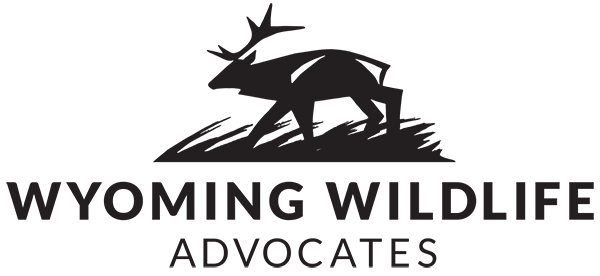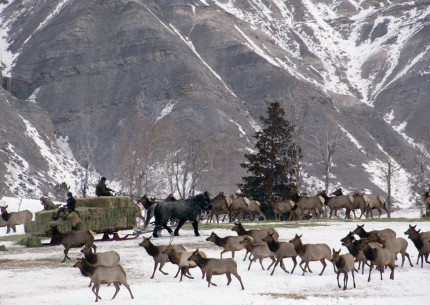by Angus M. Thuermer Jr./WyoFile | MARCH 31, 2015
The Bridger-Teton National Forest dismisses good science and the threat of chronic wasting disease and buckles under Wyoming’s political pressure as it is re-authorizing an elk feedground near Jackson, activists say.
Four conservation groups led by Western Watersheds Project filed the blunt challenge to renewal of a permit for the 91-acre Alkali Creek Feedground in the Gros Ventre River drainage earlier this month. Extending the permit for the Wyoming Game and Fish Department would ignore the serious consequence of concentrating wildlife in the face of advancing CWD, an always fatal and untreatable malady, they said.
Perpetuating winter feeding would exacerbate the spread and intensity of the disease, putting an entire ecosystem at risk, the objection said. An analysis justifying the permit isn’t independent, the critics say, instead reflecting the Wyoming Game and Fish Department point of view.
The proposal to renew the permit amounts to “another in a long line of decisions in which the BTNF has dismissed the best available science on elk feedgrounds to succumb to political pressure from the Wyoming Game and Fish Department and Commission,” Western Watersheds’ March 16 comments state. The Forest Service proposal is “replete with examples where the BTNF uses rationales that parrot the opinion or policy of the WGFD rather than heeding the overwhelming preponderance of expert opinion and science that counsels discontinuation of winter elk feedgrounds.”
Protest runs 39 pages
Forest Service officials received the 39-page Western Watersheds objection along with five other protests or letters addressing the state’s winter operation about 20 air miles northeast of Jackson. The Western Watersheds challenge, however, took direct and aggressive aim at the Wyoming Game and Fish feedground program west of the Continental Divide.
Wilderness Watch, Sierra Club Wyoming Chapter and Gallatin Wildlife Association signed the letter along with Western Watersheds. The groups said the federal agency is failing to meet environmental laws.
A principle worry is the spread of CWD, which is advancing west across Wyoming. A map prepared by Wyoming Wildlife Advocates shows an infected deer hunt area within 35 miles of a Game and Fish elk feedground in southern Sublette County.
The Watersheds coalition calls for a reassessment of the feedground permit and cessation of feeding until one is completed. A Forest Service official in Ogden, Utah where the “formal objections” to the proposal were filed in the agency’s regional office, said it would work with protesters.
“The review will happen in mid-April including resolution meetings to ensure we understand the concerns and issues,” spokesman Wade Muehlhof said in an email. “We will work hard to address the objections with an expected decision in early May.”
The Forest Service seeks to sign a Record of Decision that would complete a final supplemental environmental impact statement. That action would extend the permit to 2028.
Game and Fish is working with the Forest Service to respond to the criticism, agency spokesman Renny MacKay said in an email. “The science shows that when you look at all users on the landscape — wildlife, recreationists, agriculture and hunters — winter feedgrounds provide significant benefits,” he wrote. “We do recognize the long-term goal is to reduce dependence on feedgrounds and we are working towards that goal with the Forest Service and other partners.”
The Jackson Hole Conservation Alliance and Greater Yellowstone Coalition also wrote letters about the permit, saying impacts on wolves were not adequately considered. The Forest Service relied on an outdated CWD plan and did not consider how much natural winter forage was available to elk, the two groups said.
Outfitters want feedground to stay
But outfitters and a rancher supported extending the permit. Wyoming Outfitters & Guides Association “objects to any objections to the renewal of the Alkali feedground,” president Jesse Rodenbough wrote.
Brian Taylor, president of the Jackson Hole Outfitters and Guides Association, backed the Alkali Creek Feedground on behalf of that group and for his family, which owns a ranch in the Gros Ventre drainage about eight miles from the feedground. In two letters he said the permit should be authorized beyond the proposed 2028 date to save costs associated with renewal.
He and his father, Glenn, also contend the feedground is necessary because of wolves. Glenn Taylor ran an outfitting business started by his father in 1934, he said, and has passed the operation on to his son.
“I’m very adamant about maintaining the feedground,” Glenn Taylor said. “If we don’t, the way these wolves are depredating the elk up there we’re going to be out of business fast.”
The Jackson Elk Herd remains at Game and Fish’s population objective of 11,000 following this winter’s count, Jackson-area Game and Fish spokesman Mark Gocke said. The herd includes elk that winter up the Gros Ventre, but at least 1,000 fewer elk were counted there during the census this year.
More elk have moved back up the river since the census, Gocke said. But cow elk hunting opportunities, the key method of population control and an indicator of herd size, has been cut back in recent years. The curtailment also reflects a lower-than-desired ratio of elk calves to cows, he said.
In its scathing comments, Western Watersheds and its co-signers blast the Bridger-Teton for starting out on the wrong foot. The Forest Service began an analysis of the permit renewal with too narrow a focus, contrary to law and regulation. It did not use accurate information or look at cumulative impacts of the entire Game and Fish feedground operation, the comment letter said.
That context is important in a state where Game and Fish and the U.S. Fish and Wildlife Service feed an average of 20,500 elk a year, Western Watersheds said. “Interchange” among herds can amount to 2,536 elk a year, its letter said.
The Forest Service policy on elk feedgrounds and diseases conflicts with that of the federal Animal Plant Health Inspection Service, even though they are sibling agencies in the U.S. Department of Agriculture, the critics said. The Forest Service claimed, but didn’t show, that feedgrounds keep elk from spreading disease to domestic stock, Western Watersheds said. The Bridger-Teton didn’t properly consider fencing cattle to keep elk away from ranchers’ winter feed lines either.
Feedground critics ignore the potential impacts on ranchers, Brian Taylor said. “How are we going to address keeping these elk off the cattle feed lines,” he asked pointing to several ranches in the valley. “They’re going to have to put an Elk-Refuge type fence. It will take miles of that fence to try to keep that wildlife out. That will fall back on the hands of the property owners.”
County commissioners have banned fences that block wildlife movement, Taylor said. Elk-proof fences, “those are illegal in Teton County.”
More complaints from activists
Western Watersheds had more complaints. The Bridger-Teton confuses the spread of CWD with the level of infection, it said. A single, infected elk in a new area would amount to the disease spreading, but the number of elk infected indicates the level of the disease and is of paramount importance.
“This is why virtually every expert and expert panel in North America recommends not to densely concentrate cervids,” Western Watersheds said. “Most experts recognize that the geographic spread of CWD in the Colorado and Wyoming areas may be inevitable, but all experts counsel to mitigate the transmissibility and rate of the infection using the best known method available: don’t feed or bait in order to allow cervids to disperse in natural densities rather than higher artificial densities.”
Wildlife managers know elk move from the Gros Ventre drainage over the Continental Divide to mingle with other herds. The drainage and the Alkali feedground are a route the disease could easily follow in elk with the potential to spread across the Yellowstone ecosystem.
The Bridger-Teton and Game and Fish agree to CWD action should certain triggers be met, the critics say. But one of those triggers – CWD crossing the Continental Divide from east to west has already happened. Game and Fish discovered an infected moose in Star Valley in 2008 and three mule deer in Green River in 2012. “The failure of the BTNF to acknowledge this is troubling,” the Western Watersheds’ letter said.
Eliminating the Alkali Creek Feedground would spread elk out and slow CWD spread and infections, feedground critics said. Game and Fish itself practices “low-density feeding” in an effort to reduce the potential for disease transmission.
While Western Watersheds cites studies, literature and science, Brian Taylor would offer field observations. “I look through the ears of the horse a lot,” he said. “The eyeball test is always the best test.”
Wolves make elk bunch up anyway, Taylor said. “If CWD gets here it’s going to spread regardless if these elk are on feed or not,” he said. “The wolves have concentrated the elk. Fewer elk are utilizing winter range in the Gros Ventre. That drainage is taking a pounding.”
If CWD is going to decimate the Jackson Elk Herd, managers might as well start with a lot of elk so there would be more remaining after an outbreak, he said. Keeping Alkali Creek Feedground would help accomplish that and help keep elk healthy to fight diseases, he said. Finally, wolves chase elk off their accustomed range and that travel could increase the spread of CWD, Taylor said.
“They’re displacing elk out of Yellowstone in different directions,” he said. Some conservationists might hope elk learn to migrate in winter to the Red Desert, a historic wintering ground before establishment of the National Elk Refuge, he said. But the elk might come back infected with CWD from deer that have been documented with the disease nearby, Taylor said.
100 tons of elk feces
On the Alkali feedground, Game and Fish fed 2,345 elk a total of 132 tons of hay over 63 days in the winter of 2011-2012, Western Watersheds said. The operation fouls the environment with 100 tons of elk feces annually, it said. Yet the Bridger-Teton hasn’t accounted for any rent for the property and hasn’t said why. Effects of heavy elk browsing is seen across 350 acres of the adjacent Gros Ventre Wilderness, contrary to rules requiring that area be kept pristine, the letter said.
A “close relationship with WGFD contributed to the BTNF’s rejection out of hand of any alternative that did not continue widespread feeding,” Western Watersheds said. In fact, no analysis or scientific determination was ever conducted by the USFS as to the appropriate numbers of elk on USFS lands. Adopting Game and Fish herd objectives “transfers authority from the USFS to the WGFD,” which is inconsistent with federal laws, its letter said.
Brian Taylor can’t see a world in which elk winter naturally around Jackson Hole in the numbers they do today without supplemental feeding. That includes at Alkali Creek Feedground and the National Elk Refuge, which is adjacent to Jackson’s St. John’s Hospital.
The feedground system has worked for 100 years, he said. “I don’t think people in Jackson are going to want to see elk starve to death on the lawn of the hospital.”
Read the original WyoFile story here — link

